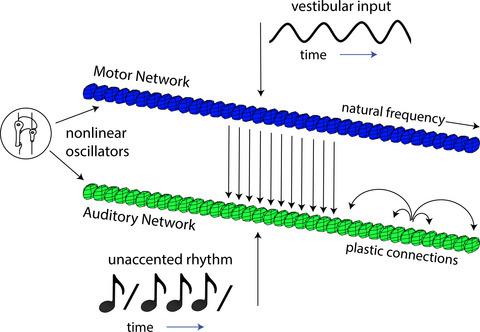Our official English website, www.x-mol.net, welcomes your feedback! (Note: you will need to create a separate account there.)
Bouncing the network: A dynamical systems model of auditory–vestibular interactions underlying infants’ perception of musical rhythm
Developmental Science ( IF 4.939 ) Pub Date : 2021-02-11 , DOI: 10.1111/desc.13103 Parker Tichko 1 , Ji Chul Kim 2 , Edward W Large 2, 3, 4
Developmental Science ( IF 4.939 ) Pub Date : 2021-02-11 , DOI: 10.1111/desc.13103 Parker Tichko 1 , Ji Chul Kim 2 , Edward W Large 2, 3, 4
Affiliation

|
Previous work suggests that auditory–vestibular interactions, which emerge during bodily movement to music, can influence the perception of musical rhythm. In a seminal study on the ontogeny of musical rhythm, Phillips-Silver and Trainor (2005) found that bouncing infants to an unaccented rhythm influenced infants’ perceptual preferences for accented rhythms that matched the rate of bouncing. In the current study, we ask whether nascent, diffuse coupling between auditory and motor systems is sufficient to bootstrap short-term Hebbian plasticity in the auditory system and explain infants’ preferences for accented rhythms thought to arise from auditory–vestibular interactions. First, we specify a nonlinear, dynamical system in which two oscillatory neural networks, representing developmentally nascent auditory and motor systems, interact through weak, non-specific coupling. The auditory network was equipped with short-term Hebbian plasticity, allowing the auditory network to tune its intrinsic resonant properties. Next, we simulate the effect of vestibular input (e.g., infant bouncing) on infants’ perceptual preferences for accented rhythms. We found that simultaneous auditory–vestibular training shaped the model's response to musical rhythm, enhancing vestibular-related frequencies in auditory-network activity. Moreover, simultaneous auditory–vestibular training, relative to auditory- or vestibular-only training, facilitated short-term auditory plasticity in the model, producing stronger oscillator connections in the auditory network. Finally, when tested on a musical rhythm, models which received simultaneous auditory–vestibular training, but not models that received auditory- or vestibular-only training, resonated strongly at frequencies related to their “bouncing,” a finding qualitatively similar to infants’ preferences for accented rhythms that matched the rate of infant bouncing.
中文翻译:

弹跳网络:婴儿对音乐节奏感知的听觉-前庭相互作用的动力系统模型
以前的工作表明,在身体随着音乐运动时出现的听觉-前庭相互作用会影响对音乐节奏的感知。在一项关于音乐节奏个体发育的开创性研究中,Phillips-Silver 和 Trainor (2005) 发现让婴儿弹跳到无重音节奏会影响婴儿对与弹跳率匹配的重音节奏的感知偏好。在目前的研究中,我们询问听觉和运动系统之间的新生、弥散耦合是否足以引导听觉系统中的短期赫布可塑性,并解释婴儿对被认为是由听觉-前庭相互作用产生的重音节奏的偏好。首先,我们指定一个非线性动态系统,其中两个振荡神经网络代表发育中的听觉和运动系统,通过弱的、非特定的耦合进行交互。听觉网络具有短期赫布可塑性,允许听觉网络调整其内在共振特性。接下来,我们模拟前庭输入(例如,婴儿弹跳)对婴儿对重音节奏的感知偏好的影响。我们发现同步的听觉-前庭训练塑造了模型对音乐节奏的反应,增强了听觉网络活动中与前庭相关的频率。此外,与仅听觉或前庭训练相比,同时听觉-前庭训练促进了模型中的短期听觉可塑性,在听觉网络中产生更强的振荡器连接。最后,当在音乐节奏上进行测试时,同时接受听觉-前庭训练的模型,
更新日期:2021-02-11
中文翻译:

弹跳网络:婴儿对音乐节奏感知的听觉-前庭相互作用的动力系统模型
以前的工作表明,在身体随着音乐运动时出现的听觉-前庭相互作用会影响对音乐节奏的感知。在一项关于音乐节奏个体发育的开创性研究中,Phillips-Silver 和 Trainor (2005) 发现让婴儿弹跳到无重音节奏会影响婴儿对与弹跳率匹配的重音节奏的感知偏好。在目前的研究中,我们询问听觉和运动系统之间的新生、弥散耦合是否足以引导听觉系统中的短期赫布可塑性,并解释婴儿对被认为是由听觉-前庭相互作用产生的重音节奏的偏好。首先,我们指定一个非线性动态系统,其中两个振荡神经网络代表发育中的听觉和运动系统,通过弱的、非特定的耦合进行交互。听觉网络具有短期赫布可塑性,允许听觉网络调整其内在共振特性。接下来,我们模拟前庭输入(例如,婴儿弹跳)对婴儿对重音节奏的感知偏好的影响。我们发现同步的听觉-前庭训练塑造了模型对音乐节奏的反应,增强了听觉网络活动中与前庭相关的频率。此外,与仅听觉或前庭训练相比,同时听觉-前庭训练促进了模型中的短期听觉可塑性,在听觉网络中产生更强的振荡器连接。最后,当在音乐节奏上进行测试时,同时接受听觉-前庭训练的模型,



























 京公网安备 11010802027423号
京公网安备 11010802027423号